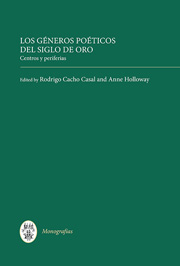Book contents
- Frontmatter
- Dedication
- Contents
- Índice de ilustrationes
- Índice de colaboradores
- Introducción: Géneros, centros, periferias
- I DEL CENTRO A LA PERIFERIA: GÉNEROS Y CONTRAGÉNEROS
- II AGUDEZA, RETÓRICA Y EMBLEMÁTICA
- 5 Invenciones cancioneriles y tradición emblemática: de la sutileza cuatrocentista a la agudeza áurea
- 6 Poesía y emblemática en el Siglo de Ora
- 7 Poesía y retórica en el Siglo de Ora: cuestiones en torno al estilo culto
- III GÓNGORA Y SU ESTELA
- IV POESÍA COLONIAL: EL NUEVO CENTRO
- V LA POESÍA Y SUS MARCOS: MANUSCRITOS, ANTOLOGÍAS, MISCELÁNEAS
- Bibliografía
- Índice onomástico
6 - Poesía y emblemática en el Siglo de Ora
from II - AGUDEZA, RETÓRICA Y EMBLEMÁTICA
Published online by Cambridge University Press: 05 September 2013
- Frontmatter
- Dedication
- Contents
- Índice de ilustrationes
- Índice de colaboradores
- Introducción: Géneros, centros, periferias
- I DEL CENTRO A LA PERIFERIA: GÉNEROS Y CONTRAGÉNEROS
- II AGUDEZA, RETÓRICA Y EMBLEMÁTICA
- 5 Invenciones cancioneriles y tradición emblemática: de la sutileza cuatrocentista a la agudeza áurea
- 6 Poesía y emblemática en el Siglo de Ora
- 7 Poesía y retórica en el Siglo de Ora: cuestiones en torno al estilo culto
- III GÓNGORA Y SU ESTELA
- IV POESÍA COLONIAL: EL NUEVO CENTRO
- V LA POESÍA Y SUS MARCOS: MANUSCRITOS, ANTOLOGÍAS, MISCELÁNEAS
- Bibliografía
- Índice onomástico
Summary
Poesía y emblemática estuvieron ligados desde antes de que se empleara el marbete emblemática para denominar esa manifestación cultural que consiste en el hermanamiento entre palabra e imagen que tanto éxito tuvo durante los siglos XVI al XVIII en Europa y América.
En algunas ocasiones se han calificado de protoemblemáticas las invenciones plástico-literarias que precedieron a la fecha de 1531 en que, con la publicación en Augsburgo del Emblematum liber de Andrea Alciato, en una edición no autorizada por él, se produjo el nacimiento de un género editorial que tuvo un éxito sin precedentes. Hasta fines del siglo XVII se produjeron 171 ediciones de los Emblemas de Alciato, no solo en latín, sino en francés, alemán, italiano y español, y muchos de sus emblemas aparecieron en inglés en A Choice of Emblems (1586) de Geffrey Whitney.
Frank B. Fieler estimó que entre 1531 y 1700 se publicaron más de 3.000 diferentes ediciones de libros de emblemas de más de 700 autores distintos. Esos datos quedan hoy obsoletos pues, en The Union Catalogue of Emblem Books, Peter Daly y sus colaboradores tienen registradas más de 6.500 obras de emblemática e imprese en todas las lenguas europeas.
- Type
- Chapter
- Information
- Los géneros poéticos del Siglo de OroCentros y periferias, pp. 109 - 132Publisher: Boydell & BrewerPrint publication year: 2013



